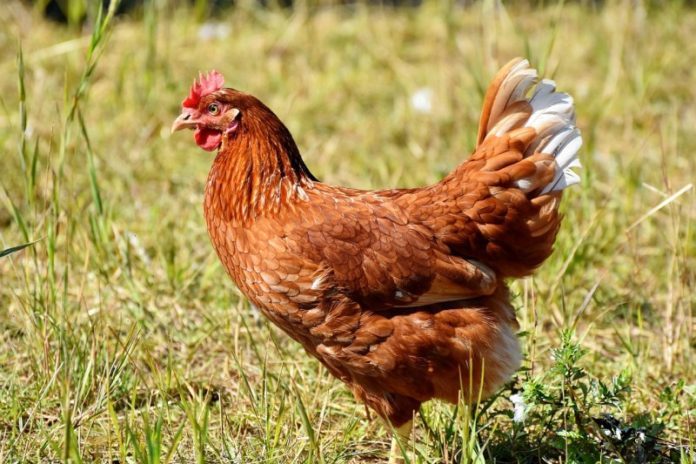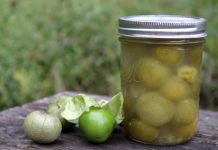There are few things better than having fresh eggs at hand for creating all kinds of mouthwatering dishes. Thanks to a resurgence in self-sufficiency, people around the world are enjoying fresh eggs from their own chickens instead of running to the grocery store to get them. Take note, however, that some chickens are better than other varieties when it comes to getting quality eggs. Read this guide to find the best egg-laying chickens for your needs, before you get your coop started.
1. Rhode Island Red
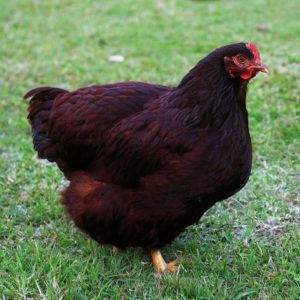

This breed adapts well to both hot and cold climates and isn’t sensitive to rain or snow. In fact, they maintain their happy-go-lucky demeanor regardless of weather and are friendly, pleasant hens to have around. The Rhode Island Red chicken is a hardy and adaptable variety, ideal for first-time farmers. Developed in—you guessed it—Rhode Island in the mid-1800s, these chooks became so popular that they ended up as RI’s state bird!
Rhode Island Reds have a deep red to almost brown color, and males have a ruby red plume and facial skin layer. This chicken breed prefers to socialize with others of their own breed, so they’re not great for mixed flocks.
These hens adapt well to either being free ranged or cooped, though they enjoy roaming time outdoors. In terms of laying capability, you’ll get an annual egg count of around 260, medium-sized brown eggs per bird.
2. White Leghorns
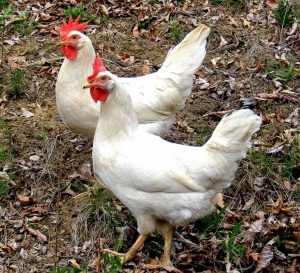

The White Leghorn chicken variety is one of the most prolific egg layers out there. They have an early maturity rate at about 16 weeks old, so they can start laying eggs while still quite young. This makes them a very popular breed for egg lovers.
Their annual laying count falls in the 280-300 range! This is in the highest egg-laying bracket, so if you really like omelets, put this breed at the top of your list.
This chicken variety lays large, white eggs, which can often have double yolks. They’re beautiful birds, with tall, slender statures and white plumage, upright tail feathers, and long legs. In terms of temperament, they’re known to be skittish and will often take flight if provoked. As such, they’re better suited to more experienced farmers who have the proper equipment to suit their needs.
3. Golden Comet
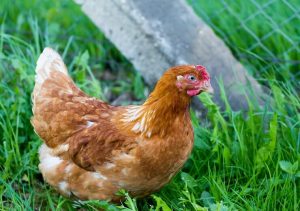

Golden Comet chickens are a cross between Rhode Island Reds and White Leghorns. Amazingly, they’ve inherited the best traits from both breeds. Plump and stout, these chickens have dark, golden feathers, and occasional white lacing on their necks and tails.
These gorgeous birds have more than just their looks going for them. Golden Comets are well known—and preferred—for their easygoing, calm demeanor. This breed’s nature makes them one of the best egg-laying chickens for small areas. They’re also ideal as household pets… though you might want to invest in some chicken diapers if you let them live indoors.
Golden Comets are naturally and mothering, and are as nurturing with their own chicks as they are with human children. They’re affectionate and gentle, and if you choose to breed yours, you can rest assured they’ll mother their offspring well. This breed is also friendly with different chicken breeds, so they’re ideal for mixed flocks.
Comets have an annual egg count of between 275 and 330 large, brown eggs. As such, they’re preferred by those who sell their eggs at farmers’ markets.
Related: How to Make a Natural Dewormer for Chickens from Pumpkin Seeds
4. Barred Plymouth Rock
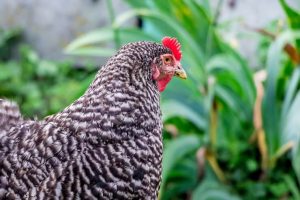

Barred Plymouth Rock chickens are on the larger side, and this helps them to be highly resistant to cold temperatures. They have a round, robust body size and are covered with white and black speckled features on top of a fluffy gray undercoat. These layers make them perfect for cold climates like the northern USA and Canada since they can endure snowy weather well.
This breed has a high annual egg-laying rate, at approximately 280 large, peach-colored eggs at a constant, predictable rate. They’re also known to be quite calm and content in nature. Due to this pleasant demeanor, they get along well with other animals, whether livestock or household pets.
5. Golden Laced Wyandottes
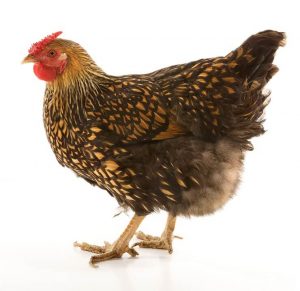

Golden-Laced Wyandotte chickens are known for their curious temperament. They love to forage, which makes them a perfect breed if you’re looking for chickens that will be able to fend for themselves. They are predictable, highly energetic nature makes Wyandottes a great breed choice if you want to raise free-range birds.
By having a chicken breed that forages well, you’ll be able to lower your chicken feed expenses exponentially. Your hens can hunt for their own food outside and are great for clearing “pest” insects like slugs and caterpillars from your vegetable garden.
Golden Laced Wyandottes have beautiful, black-tipped, dark brown feathers. Expect around 200 small, white eggs from your hens every year.
6. Buff Orpington
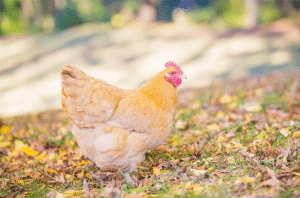

These golden girls are sure to be a hoot in your flock. They’re a top breed to consider if you’re planning to raise chickens in pens. Their fluffy feather layers make them cold hardy, but they don’t handle heat well.
Buff Orpington chickens are medium-sized birds with gold-yellow feathers. They can be expected to lay around 200 small, light brown eggs every year. They’re very tame in nature when alone, and social in groups.
Their friendly attitude makes them an ideal chicken breed for suburban farmers and garden growers who have limited space, or those who choose to raise their birds in coops. These big, friendly birds are also incredibly smart. Some farmers have even trained their Buff Orpingtons to obey commands!
7. Ameraucana
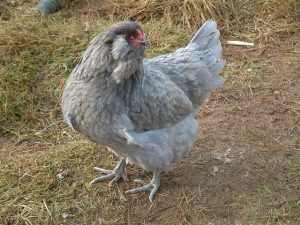

These hens are also called “Easter Eggers”, or “Easter Egg chickens”. They produce a large number of eggs annually, with shell hues in all shades of pink, blue, and green. They were bred in the United States in the 1970s, derived from Chilean Araucana hens.
Ameraucanas are known for their gorgeous appearance. These beauties are medium brown with white, yellow, and deep brown speckles, and golden beaks. Their appearance ensures that you that you’ll never tire of watching these supermodels outside your window. They have an odd body shape with a stout beak, slanted lower tail feathers, long neck, and stout head.
Their yearly egg rate is about 260, and the hens are known to quite broody. This means that they’re overly protective of their fertile eggs, especially around fellow hens. Other than their motherly attitude, they are generally well behaved.
8. Andalusian
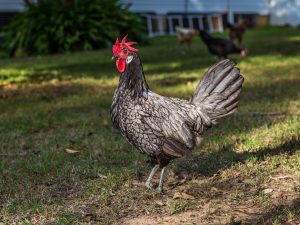

Andalusians are known for their small stature and are the opposite of Barred Plymouths in every way. They have a high heat tolerance and stunning blue-black feathers. They lay approximately 170 large, white eggs annually, which is on the lower end of the laying scale. That said, they have the highest laying rate among heat-tolerant varieties.
Indigenous to southwestern Spain, Andalusian chickens thrive best in hot climates. This makes them ideal for egg lovers in the southern USA, and warmer European regions. They’re known to jump, run, and take flight, but are typically non-aggressive in nature.
This is a rare variety that may be a bit more difficult to find. It is, however, gaining in popularity thanks to chicken hobbyists.
Are You Ready to Raise Backyard Chickens?
Thanks to recent bylaw changes, many people in suburban areas have permission to raise chickens in their backyards. These permissions are limited so specific areas and have to adhere to certain requirements. If you’ve been toying with the idea of raising your own hens, find out whether you’re permitted to do so.
The most important thing to mention in this article, however, is to be make sure that you are 100% ready to raise hens before even looking at buying or building a chicken coop.
First, make sure that you have adequate space on your property. Chickens need enough room to spread their wings and get their recommended amount of exercise. You need to meet your area’s laws and safety standards for a chicken coop and pen. These ensure that your chickens will be safe from predators and inclement weather.
Be careful if you live in an area where wildlife runs rampant. It might not be the best thing to add chickens to the mix, as you may put their lives at risk. In addition, chickens require food and water that might not be readily available at a local store.
A Final Note:
The most important thing to remember is that chickens are living beings that need proper care. They need love, attention, and affection just like any other animal, and can’t just be tossed in a pen and neglected. You have to ensure that you have the time and energy to interact with them and check them regularly for any health issues.
Chickens are a lot of fun to raise, but they’re also a big responsibility. If you’re dedicated and willing to put in the time and effort, then go right ahead. Set up a coop, get yourself a couple of hens, and experience the joy of farm-fresh eggs every day



